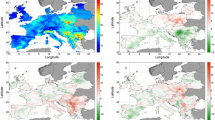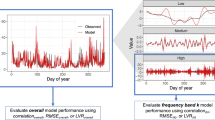Abstract
The real-world monitoring system of air pollution ordinarily collects data about pollutant concentration levels at pollution sources and monitors stations in a high-frequency manner. Inspired atmospheric models, the meteorological conditions could play an important role in building up the data-driven model for dispersing atmospheric pollutants from pollution sources to monitor stations. We propose a varying-coefficient model to analyze how emissions of monitor stations are influenced by pollution sources with changing with the wind speed. To estimate the unknown coefficient curves, we use a spline basis to approximate the functions. The asymptotic properties of the proposed method are studied and show the consistency of the estimator. Inference procedures based on a resampling subject bootstrap is developed to construct the conservative confidence bands. A simulation study is carried out to demonstrate the performance of our method. Illustrated by a real-world dataset of environmental sensors collected in Shenyang, China, the proposed varying-coefficient model reveals that the wind speed changes the dispersion mechanism of atmospheric pollutants between monitor stations and pollution sources.




Similar content being viewed by others
Data availability
The data are provided on GitHub at https://github.com/rucwyf/VCMData.
Code Availability
Code upon request.
References
Boor CD (1978) A practical guide to splines. Springer, New York
Chiang C-T, Rice JA, Wu CO (2001) Smoothing spline estimation for varying coefficient models with repeatedly measured dependent variables. J Am Stat Assoc 96(454):605–619
Cimorelli AJ, Perry SG, Venkatram A, Weil JC, Paine RJ, Wilson RB, Lee RF, Peters WD, Brode RW (2005) AERMOD: a dispersion model for industrial source applications. part I: general model formulation and boundary layer characterization. J Appl Meteorol 44(5):682–693
Davidian M, Giltinan DM (1995) Nonlinear models for repeated measurement data. Chapman Hall, London
Diggle P, Heagerty PJ, Liang K-Y, Zeger SL (1994) Analysis of longitudinal data. Oxford University Press, Oxford
Efron B (1981) Nonparametric standard errors and confidence intervals. Can J Stat-revue Canadienne De Statistique 9(2):139–158
Efron B (1982) The jackknife, the bootstrap, and other resampling plans. Siam, Philadelphia
Efron B (1987) Better bootstrap confidence intervals. J Am Stat Assoc 82(397):171–185
Fan J, Ma Y, Dai W (2014) Nonparametric independence screening in sparse ultra-high-dimensional varying coefficient models. J Am Stat Assoc 109(507):1270–1284
Fan J, Zhang W (2008) Statistical methods with varying coefficient models. Stat Interface 1(1):179–195
Gibson MD, Kundu S, Satish M (2013) Dispersion model evaluation of PM2.5, NOx and SO2 from point and major line sources in Nova Scotia, Canada using AERMOD Gaussian plume air dispersion model. Atmos Pollut Res 4(2):157–167
He K, Lian H, Ma S, Huang JZ (2018) Dimensionality reduction and variable selection in multivariate varying-coefficient models with a large number of covariates. J Am Stat Assoc 113(522):746–754
Henry RC, Chang Y-S, Spiegelman CH (2002) Locating nearby sources of air pollution by nonparametric regression of atmospheric concentrations on wind direction. Atmos Environ 36(13):2237–2244
Hoover DR, Rice JA, Wu CO, Yang L-P (1998) Nonparametric smoothing estimates of time-varying coefficient models with longitudinal data. Biometrika 85(4):809–822
Huang J, Horowitz JL, Wei F (2010) Variable selection in nonparametric additive models. Ann Stat 38(4):2282–2313
Huang JZ, Wu CO, Zhou L (2002) Varying-coefficient models and basis function approximations for the analysis of repeated measurements. Biometrika 89(1):111–128
Huang JZ, Wu CO, Zhou L (2004) Polynomial spline estimation and inference for varying coefficient models with longitudinal data. Stat Sin 14(3):763–788
Lai M-J, Schumaker LL (2007) Spline functions on triangulations. Cambridge University Press, Cambridge
Lee K, Lee YK, Park BU, Yang SJ (2018) Time-dynamic varying coefficient models for longitudinal data. Comput Stat Data Anal 123:50–65
Lin H, Zhang R, Shi J (2017) Local estimation for varying-coefficient models with longitudinal data. Commun Stat-theory Methods 46(15):7511–7528
Liu S (2017) Efficient estimation of longitudinal data additive varying coefficient regression models. Acta Math Appl Sin 33(2):529–550
Liu S, Lian H (2018) Robust estimation and model identification for longitudinal data varying-coefficient model. Commun Stat-Theory Methods 47(11):2701–2719
Lushi E, Stockie JM (2010) An inverse Gaussian plume approach for estimating atmospheric pollutant emissions from multiple point sources. Atmos Environ 44(8):1097–1107
Pancras JP, Ondov JM, Poor N, Landis MS, Stevens RK (2006) Identification of sources and estimation of emission profiles from highly time-resolved pollutant measurements in Tampa, FL. Atmos Environ 40:467–481
Park BU, Mammen E, Lee YK, Lee ER (2015) Varying coefficient regression models: a review and new developments. Int Stat Rev 83(1):36–64
Ramsay JO, Silverman BW (2005) Functional data analysis, 2nd edn. Springer Science & Business Media, New York
Schumaker L (2007) Spline functions: basic theory, 3rd edn. Cambridge University Press, Cambridge
Tang Q, Cheng L (2008) M-estimation and B-spline approximation for varying coefficient models with longitudinal data. J Nonparametric Stat 20(7):611–625
Venkatram A, Fitz D, Bumiller K, Du S, Boeck M, Ganguly C (1999) Using a dispersion model to estimate emission rates of particulate matter from paved roads. Atmos Environ 33(7):1093–1102
Verbeke G, Molenberghs G (2000) Linear mixed models for longitudinal data. Springer, New York
Vonesh EF, Chinchilli VM (1996) Linear and nonlinear models for the analysis of repeated measurements. Marcel Dekker, New York
Weitkamp EA, Lipsky EM, Pancras PJ, Ondov JM, Polidori A, Turpin BJ, Robinson AL (2005) Fine particle emission profile for a large coke production facility based on highly time-resolved fence line measurements. Atmos Environ 39(36):6719–6733
Williams B, Christensen WF, Reese CS (2011) Pollution source direction identification: embedding dispersion models to solve an inverse problem. Environmetrics 22(8):962–974
Wu CO, Yu KF (2002) Nonparametric varying-coefficient models for the analysis of longitudinal data. Int Stat Rev 70(3):373–393
Xue L, Zhu L (2007) Empirical likelihood for a varying coefficient model with longitudinal data. J Am Stat Assoc 102(478):642–654
Zhang X, Wang J-L (2015) Varying-coefficient additive models for functional data. Biometrika 102(1):15–32
Zhao P, Xue L (2009) Empirical likelihood inferences for semiparametric varying-coefficient partially linear errors-in-variables models with longitudinal data. J Nonparametric Stat 21(7):907–923
Acknowledgements
The authors thank the editor, the associate editor, and the reviewers for their comments that helped significantly improve this work. This research was supported by the National Key R &D Program of China (Grant No. 2018YFC2000302), by Public Computing Cloud, Renmin University of China, and partially by the National Natural Science Foundation of China (Grant No. 11801560).
Author information
Authors and Affiliations
Contributions
Conceptualization and data preparation: HY; Methodology: KH;Simulation and real data analysis:YW and WS;Writing—original draft preparation: KH and WS; Writing—review and editing: KH, YW and HY.
Corresponding author
Additional information
Handling Editor Pierre Dutilleul.
Supplementary Information
Below is the link to the electronic supplementary material.
Rights and permissions
About this article
Cite this article
He, K., Wang, Y., Su, W. et al. A varying-coefficient regression approach to modeling the effects of wind speed on the dispersion of pollutants. Environ Ecol Stat 29, 433–452 (2022). https://doi.org/10.1007/s10651-022-00535-6
Received:
Accepted:
Published:
Issue Date:
DOI: https://doi.org/10.1007/s10651-022-00535-6




